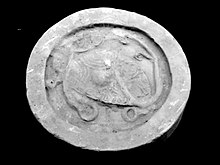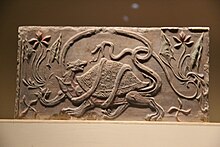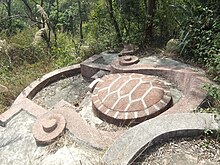Black Tortoise
| Black Tortoise | |||||||||||
|---|---|---|---|---|---|---|---|---|---|---|---|
 The Black Tortoise depicted on a Chinese tile | |||||||||||
| Chinese name | |||||||||||
| Chinese | Huyền Vũ | ||||||||||
| Literal meaning | Mysterious ~ Dark ~ Black Warrior | ||||||||||
| |||||||||||
| Vietnamese name | |||||||||||
| Vietnamese Alpha bet | Huyền Vũ | ||||||||||
| Chữ Hán | Huyền Vũ | ||||||||||
| Korean name | |||||||||||
| Hangul | 현무 | ||||||||||
| Hanja | Huyền Vũ | ||||||||||
| |||||||||||
| Japanese name | |||||||||||
| Kanji | Huyền Vũ | ||||||||||
| Hiragana | げんぶ | ||||||||||
| |||||||||||
| Black Warrior of the North | |||||||
|---|---|---|---|---|---|---|---|
 A copper Black Tortoise from theYongle eraof theMing dynasty(early 15th century) | |||||||
| Chinese | Phương bắc Huyền Vũ | ||||||
| |||||||
TheBlack Tortoiseis one of theFour Symbolsof theChinese constellations.It is usually depicted as atortoiseintertwined with asnake.[1]The character ' võ ' can mean 'martial' or 'warrior.' The two characters huyền and võ do not have any literal meaning of tortoise and snake. But both tortoise and snake are known to hibernate during winter. The image of intertwined tortoise and snake likely symbolizes a state of inner struggle[citation needed]or a state of hibernation, and thus implies the season of winter. So the English translationBlack ~ Dark ~ Mysterious Warrior[a]is a more faithful translation.[4][5]
It represents thenorthand thewinterseason, thus it is sometimes calledBlack Warrior of the North(Chinese:Phương bắc Huyền Vũ;pinyin:Běifāng Xuánwǔ).
In Japan, the characters Huyền Vũ are pronounced asGenbu.It is said to protectKyotoon the north side, being one of the four guardian spirits that protect the city. It is represented by theKenkun Shrine,which is located on top of Mt Funaoka in Kyoto.
An importantTaoistpriest also has Huyền VũXuanwuas his clergy name. He is sometimes (as inJourney to the West) portrayed in the company of a turtle and a snake.
History[edit]
During theHan dynasty,people often worejadependants that were in the shape of turtles. Originally, there was a legend that said that turtles could not mate with other turtles, only snakes. This is why the Black Tortoise is depicted with a snake on its back.
The northern gates ofChinese palaceswere often named after the Xuanwu. Most famously, theIncident at Xuanwu Gate,whereLi Shiminkilled his brothersJianchengandYuanjiand seized power in a coup, took place at the north gate of theTaiji Palace,in the north ofChang'an.
Legends[edit]

In ancientChina,thetortoiseand theserpentwere thought to be spiritual creatures symbolizing longevity. TheMin peoplecustom of buildingturtle-shaped tombsmay have had to do with the desire to place the grave under the influence of the Black Tortoise.[6][7]
Xuanwu[edit]

In theclassic novelJourney to the West,Xuanwuwas a king of the north who had two generals serving under him, a "Tortoise General" and a "Snake General". This god had a temple in theWudang MountainsofHubeiand there are now a "Tortoise Mountain" and a "Snake Mountain" on opposite sides of a river nearWuhan,Hubei's capital.Taoist legendhas it that Xuanwu was the prince of a Chinese ruler but was not interested in taking the throne, opting instead to leave his parents at age 16 and study Taoism. According to the legend, he eventually achieved divine status and was worshiped as a deity of the northern sky.
Other Chinese legends[citation needed]also speak of how the "Tortoise General" and a "Snake General" came to be. During Xuanwu's study to achieve enlightenment and divine status, he was told that, in order to fully achieve divinity, he must purge all human flesh from his body. Since he had always eaten thefood of the world,despite all his efforts, his stomach and intestines were still human. A god[which?]then came and changed his organs with divine ones. Once removed, the original stomach and intestines were said to have become a tortoise and a snake, respectively. The tortoise and snake became demons[citation needed]and terrorized people. Now divine, Xuanwu heard of this and returned to slay the monsters he had unleashed on the countryside. However, as the snake and tortoise showed remorse, he did not kill them but instead let them train under him to atone for their wrongdoings. They then became the Tortoise and Snake generals and assisted Xuanwu with his quests (another legend held that the mortal organs were tossed out to become Wuhan's Tortoise and Snake mountains).
According to another source,[citation needed]once Xuanwu had begun his study of theWay,he discovered that he must purge himself of all of his past sins to become a god. He learned to achieve this by washing his stomach and intestines in the river. Washing his internal organs, his sins dissolved into the water in a dark, black form. These then formed into a black tortoise and a snake who terrorized the country. Once Xuanwu learned of this, he returned to subdue them as in the other story.
Seven Mansions of the Black Tortoise[edit]
As with the other threeSymbols,there are seven astrological "Mansions" (positions of theMoon) within the Black Tortoise. The names and determinative stars are:[8][9]
| Mansion no. | Name | Pinyin | Translation | Determinative star |
|---|---|---|---|---|
| 8 | Đấu | Dǒu | (Southern)Dipper | φ Sgr |
| 9 | Ngưu | Niú | Ox | β Cap |
| 10 | Nữ | Nǚ | Girl | ε Aqr |
| 11 | Hư | Xū | Emptiness | β Aqr |
| 12 | Nguy | Wēi | Rooftop | α Aqr |
| 13 | Thất | Shì | Encampment | α Peg |
| 14 | Vách tường | Bì | Wall | γ Peg |

See also[edit]
- Ao- the great turtle of early Chinese mythology
- Bixi- the son of theDragon Kingwho supports Chinesestelæ
- Cetus in Chinese astronomy-Cetusand Black Tortoise correspond onastrology,and both creatures possess affinities to waters and travel to underworlds to guide people[10][11]
- Fushigi Yûgi: Genbu Kaiden
- Gamera- the fictionalkaijubeing repeatedly referenced to the Black Tortoise
Notes[edit]
- ^Eastern HanphilologistXu Shenstated thatVõ;wǔ"warrior" was aJianghuaidialectal word forSĩ;shì"knight"when annotating this passage“Phu tử sinh cùng vực, không thể hiếp lăng, dũngVõMột người, vì tam quân hùng.”"One for whom death and life are the same territory, who cannot be threatened, such a single bravewarrioris the hero of the Three Armies. "[2][3]
References[edit]
- ^Chen, Sanping; Mair, Victor H. (2017-04-02)."A" Black Cult "in Early Medieval China: Iranian-Zoroastrian Influence in the Northern Dynasties".Journal of the Royal Asiatic Society.27(2): 208.doi:10.1017/s1356186316000584.ISSN0035-869X.S2CID164550058– via JSTOR.
- ^Liu An(compiler),Xu Shen(annotator).Huainanzi,"Survey Obscurities". Main text: “Phu tử sinh cùng vực, không thể hiếp lăng, dũngVõMột người, vì tam quân hùng.”; Annotation: “VõSĩ cũng; Giang Hoài gian gọi sĩ rằngVõ.”;Siku Quanshuversion. vols. 4-7,p. 96 of 160
- ^Liu An (2010)The Huainanzi: A Guide to the Theory and Practice of Government in Early Han China.Translated and edited by John S. Major, Sarah A. Queen, Aandrew Seth Meyer, and Harold D. Roth. New York: Columbia University Press, 2010. p. 215
- ^Zhang, Qian (2017)."China's guardians of the galaxy".Shanghai Daily.
The four beasts are Qing Long (Azure Dragon), the guardian of the East; Bai Hu (White Tiger), the guardian of the West; Zhu Que (Vermilion Bird), the guardian of the South; andXuan Wu (Black Warrior),the guardian of the North. This quartet originated from the 28 xing xiu ( "mansions" ) in the Chinese constellation system.
- ^Pregadio, Fabrizio (editor) (2008).The Encyclopedia of Taoism A-Z: Volume 1 & 2.p. 119, 194, 223, 478, 909, 1266
- ^de Groot, Jan Jakob Maria (1892),The Religious System of China,vol. III, Brill Archive, pp. 1082–1083
- ^Lý vĩnh cầu(Li Yongqiu) (2010-03-07),Các quê quán phần mộ tạo hình[In every land, its own kind of graves],Sin Chew Daily,archived fromthe originalon 2010-05-31,retrieved2012-03-21
- ^"The Chinese Sky".International Dunhuang Project.Archived fromthe originalon 2015-11-04.Retrieved2011-06-25.
- ^Sun, Xiaochun (1997).Helaine Selin(ed.).Encyclopaedia of the History of Science, Technology, and Medicine in Non-Western Cultures.Kluwer Academic Publishers.p. 517.ISBN0-7923-4066-3.Retrieved2011-06-25.
- ^National Museum of Korea,2007,Black Tortoise and Serpent, the Guardian Deity of the North
- ^Nancy Thomson de Grummond,2006, Etruscan Myth, Sacred History, and Legend,The Journey to the Afterlife,p.212,University of Pennsylvania Museum of Archaeology and Anthropology
